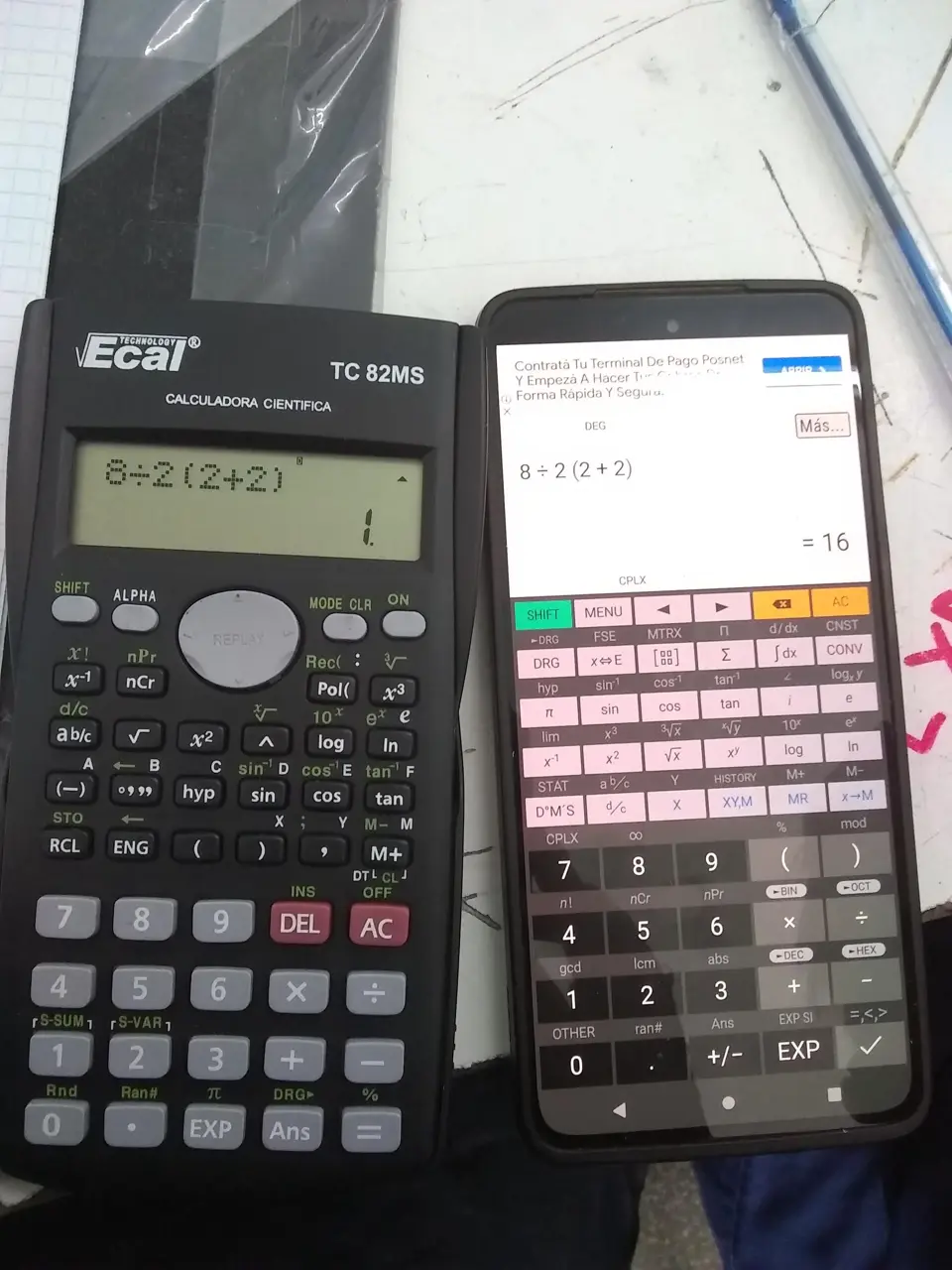this post was submitted on 03 Dec 2023
389 points (95.6% liked)
196
16888 readers
2135 users here now
Be sure to follow the rule before you head out.
Rule: You must post before you leave.
If you have any questions, feel free to contact us on our matrix channel.
founded 2 years ago
MODERATORS
you are viewing a single comment's thread
view the rest of the comments
view the rest of the comments

My Casio calculators get this wrong, even the newer ones. BTW the correct answer is 16, right?
(8 ÷ 2) × (2 + 2)8 ÷ (2 × (2 + 2))2 2 + 8 2 ÷ × .(× (÷ 8 2) (+ 2 2))prefix notation doesn't need parentheses either though, at least in this case. lisp uses them for readability and to get multiple arity operators. infix doesn't have any ambiguity either if you parenthesize all operations like that.
There isn't any ambiguity even if you don't.
PEMDAS is actually (PE)(MD)(AS). Those that are grouped together have equal precedence and are evaluated left to right.
8 / 2 * (2+2)
8 / 2 * 4
4 * 4
16
Edit to fix formatting, maybe?
When you added the multiply you changed the answer, because the (2+2) is now in the numerator instead of in the denominator.
You added brackets and changed the answer. 2(2+2) is a single term, and if you break it up then you change the answer (because now the (2+2) is in the numerator instead of in the denominator).
The only right answer
Nope, 1 is the only correct answer.
Except they don't. This isn't a notation problem, it's a people don't remember the rules of Maths problem.
Yes
8 / 2 (2+2)
8 / 2 (4)
4 (4)
16
No
8 / 2 (2+2)
8 / 2 (4)
8 / 8
1
No. Order of operations is left to right, not right to left. 1 is wrong.
Order of operations is BEDMAS, THEN left to right within each operator.
1 is the only correct answer.
a(b) is a×b. Step 2 could be rewritten as 8 / 2 × 4. Working left to right, step 3 becomes 4 × 4.
No, because implicit multiplication binds more tightly than explicit. a/b(c) becomes a/(b×(c))
Says who?
Most maths textbooks written by mathematicians.
I don't mean when they're explaining "here's how the order of operations works". I mean in the basic way that they write more advanced problems and the answers they give for them.
This video, and the prequel to it linked in the description, go into some detail showing who uses what convention and why.
Interestingly I’ve wondered if this is regional, as a fellow Aussie I learned the same as you but it seems in other places they learn the other way
FWIW I went to school in Asia, using an internationally-focused curriculum, rather than going through the Australian curriculum here in Aus.
The video I linked includes some discussion with a calculator manufacturer who apparently is under the impression that teachers in North America are asking for strict BIDMAS, so the calculator manufacturer actually switched their calculators to doing that. Until they then got blowback from the rest of the world's teachers, so they switched back to BIDMAS with juxtaposition being prioritised over division. The video also presents the case that outside of teachers—among actual maths and physics academics—prioritising juxtaposition is always preferred, even in North America.
I'm an Australian teacher who has also taught the U.K. curriculum (so I have textbooks from both countries) and, based on these comments you mention, have also Googled some U.S. textbooks, and I've yet to see any Maths textbooks that teach it "the other way". I have a very strong suspicion that it's just a lot of people in the U.S. claiming they were taught that way, but not actually being true. I had someone from Europe claim the way we (and the U.K.) teach it wasn't taught there (from memory it was Lithuania, but I'm not sure now), so I just Googled the curriculum for their country and found that indeed it is taught the same way there as here. i.e. people will just make up things in order not to admit they were wrong about something (or that their memory of it is faulty).
Huh, I'll be darned. I'm not as much of a math nerd as I thought
Here is an alternative Piped link(s):
This video
Piped is a privacy-respecting open-source alternative frontend to YouTube.
I'm open-source; check me out at GitHub.
Ignore the video - she completely ignored Maths textbooks (and yes, you're right, the rules are in Maths textbooks - quoted multiple times here).
That's exactly where the calculators in the op differ. For more examples, Casio calculators do implicit multiplication first, while ti's treat it the same as explicit multiplication and division. I think that the latter is more predictable personally, but really you just need to know your calculator.
Actually they follow the actual rules of Maths - Terms and The Distributive Law.
Write it out on paper, with numerator above the denominator. You'd have to write 8(2+2), 2(2+2) can only be written if both are in the denominator.
Depends on the system you use. Most common system worldwide and in the academic circles (the oldest of the two) has 1 as the answer.
There are no other systems - only people who are following the actual rules of Maths and those who aren't. And yes, 1 is the correct answer
No, the correct answer is 1.